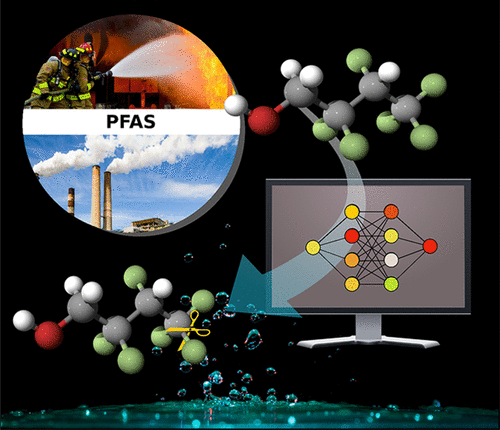当前位置:
X-MOL 学术
›
Environ. Sci. Technol. Lett.
›
论文详情
Our official English website, www.x-mol.net, welcomes your
feedback! (Note: you will need to create a separate account there.)
A Machine Learning Approach for Predicting Defluorination of Per- and Polyfluoroalkyl Substances (PFAS) for Their Efficient Treatment and Removal
Environmental Science & Technology Letters ( IF 8.9 ) Pub Date : 2019-09-12 , DOI: 10.1021/acs.estlett.9b00476 Akber Raza , Sharmistha Bardhan , Lihua Xu , Sharma S. R. K. C. Yamijala , Chao Lian , Hyuna Kwon , Bryan M. Wong
Environmental Science & Technology Letters ( IF 8.9 ) Pub Date : 2019-09-12 , DOI: 10.1021/acs.estlett.9b00476 Akber Raza , Sharmistha Bardhan , Lihua Xu , Sharma S. R. K. C. Yamijala , Chao Lian , Hyuna Kwon , Bryan M. Wong

|
We present the first application of machine learning on per- and polyfluoroalkyl substances (PFAS) for predicting and rationalizing carbon–fluorine (C–F) bond dissociation energies to aid in their efficient treatment and removal. Using a variety of machine learning algorithms (including Random Forest, Least Absolute Shrinkage and Selection Operator Regression, and Feed-forward Neural Networks), we were able to obtain extremely accurate predictions for C–F bond dissociation energies (with deviations less than 0.70 kcal/mol) that are within chemical accuracy of the PFAS reference data. In addition, we show that our machine learning approach is extremely efficient, requiring less than 10 min to train the data and less than a second to predict the C–F bond dissociation energy of a new compound. Most importantly, our approach only needs knowledge of the simple chemical connectivity in a PFAS structure to yield reliable results—without recourse to a computationally expensive quantum mechanical calculation or a three-dimensional structure. Finally, we present an unsupervised machine learning algorithm that can automatically classify and rationalize chemical trends in PFAS structures that would otherwise have been difficult to humanly visualize or process manually. Collectively, these studies (1) comprise the first application of machine learning techniques for PFAS structures to predict/rationalize C–F bond dissociation energies and (2) show immense promise for assisting experimentalists in the targeted defluorination of specific bonds in PFAS structures (or other unknown environmental contaminants) of increasing complexity.
中文翻译:

预测全氟和多氟烷基物质(PFAS)脱氟以进行有效处理和去除的机器学习方法
我们介绍了对全氟烷基物质和多氟烷基物质(PFAS)进行机器学习的第一个应用,用于预测和合理化碳氟(C-F)键解离能,以帮助其有效处理和去除。通过使用多种机器学习算法(包括随机森林,最小绝对收缩和选择算子回归以及前馈神经网络),我们能够获得关于CF键离解能的极其准确的预测(偏差小于0.70 kcal / mol)在化学精度范围内PFAS参考数据。此外,我们证明了我们的机器学习方法非常有效,需要不到10分钟的时间来训练数据,而用不到一秒钟的时间来预测新化合物的CF键解离能。最重要的是,我们的方法只需要知道PFAS结构中简单的化学连通性知识即可产生可靠的结果,而无需求助于计算量大的量子力学计算或三维结构。最后,我们提出了一种无监督的机器学习算法,该算法可以自动分类和合理化PFAS结构中的化学趋势,否则这些化学趋势将很难人工可视化或手动处理。总的来说,PFAS结构(或其他未知环境污染物)中特定键的靶向脱氟,其复杂性不断提高。
更新日期:2019-09-12
中文翻译:

预测全氟和多氟烷基物质(PFAS)脱氟以进行有效处理和去除的机器学习方法
我们介绍了对全氟烷基物质和多氟烷基物质(PFAS)进行机器学习的第一个应用,用于预测和合理化碳氟(C-F)键解离能,以帮助其有效处理和去除。通过使用多种机器学习算法(包括随机森林,最小绝对收缩和选择算子回归以及前馈神经网络),我们能够获得关于CF键离解能的极其准确的预测(偏差小于0.70 kcal / mol)在化学精度范围内PFAS参考数据。此外,我们证明了我们的机器学习方法非常有效,需要不到10分钟的时间来训练数据,而用不到一秒钟的时间来预测新化合物的CF键解离能。最重要的是,我们的方法只需要知道PFAS结构中简单的化学连通性知识即可产生可靠的结果,而无需求助于计算量大的量子力学计算或三维结构。最后,我们提出了一种无监督的机器学习算法,该算法可以自动分类和合理化PFAS结构中的化学趋势,否则这些化学趋势将很难人工可视化或手动处理。总的来说,PFAS结构(或其他未知环境污染物)中特定键的靶向脱氟,其复杂性不断提高。











































 京公网安备 11010802027423号
京公网安备 11010802027423号